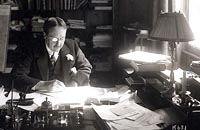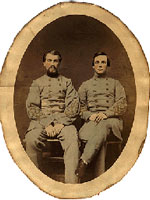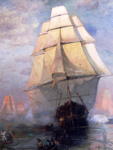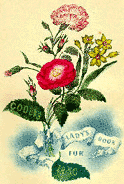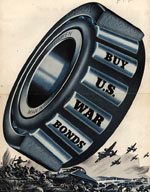A Sailor's Life for Me! is a superb example of how the web can bring history alive for young students.
The website presents an idea of what daily life would have been like aboard the famed USS Constitution, which actively fought in the Quasi War with France, the Barbary Wars, and the War of 1812. Its ability to withstand enemy fire eventually gained it the moniker of "Old Ironsides."
There are three main sections to the site, as well as supplementary materials. The primary sections are a "life of" game, an exploration of the areas aboard the vessel, and an introduction to the men who would have sailed aboard her.
Explore Old Ironsides is perhaps the most informative section. Here, the ship is divided into 24 interactive scenes which introduce shipboard activities—from battle roles, flogging, and burial to the more common activities of dining, holystoning (deck maintenance), and what sailors did with their moments of free time. Each section can be explored clicking on people and items. Clicking provides commentary from fictional sailors (complete with highlighted vocabulary terms), actions and sound effects that bring the scene to life, short biographies of historical USS Constitution sailors, and information on tasks and objects in the scenes. Life stories of the real sailors range from fairly typical naval experiences to an unfortunate sailor who wounded himself by rolling out of his hammock and down a hatch. Two remaining scenes give an idea of where and why people would sign up for voyages and the triumphant return of Old Ironsides.
These scenes provide a strong introduction to shipboard life, covering the basics in an approachable picture-book-like format. The downside is that there is enough information and detail that this portion of the site takes some time to cover in its entirety. Educators may wish to peruse the vessel sections, and select a few scenes that they feel are most important to the topic at hand. There is a seek-and-find incentive for students interested in exploring the entire ship, however, as the ship's dog, Guerriere (also the name of the most famed enemy vessel confronted by the USS Constitution) is located in 11 of the scenes.
Meet Your Shipmates introduces the crew by job and number. For example, the page shows the rank system aboard the vessel as well as how many individuals fit within each rank—from the one captain to the 276 able seamen, 55 ordinary seamen, and 12 boys. Additional roles include quartermasters, boatswain's mates, gunner's mates, the carpenter's mate, the carpenter's yeoman, the sailmaker's mate, the coxwain, the cook, the midshipmen, master's mates, the sailmaker, the carpenter, the gunner, surgeon's maters, the sailing-master, the surgeon, the chaplain, the purser, and lieutenants. Each of these sections can be clicked on for a brief description of the role of the individual(s) in question. Some roles even include a short "diary" of someone known to have served aboard the vessel—including David Debias, a free-born African American ship's boy who tragically crossed into Mississippi and was mistaken for an escaped slave.
The final main section of the site is the interactive game—the site's centerpiece. You begin the game preparing for life as a ship's boy. If students are interested in rising in the ranks, they will want to login to save their progress. Otherwise, the game can be played without registering. As a boy, you engage in tasks such as holystoning the deck, carrying powder for gun drill, and carrying slops without tripping. You are periodically confronted by superiors who ask questions that will increase and decrease your likelihood of promotion, health and happiness, spending money, and popularity with the crew. The game can be repetitive (not unlike life at sea), but may engage students who would otherwise be uninterested in the topic.
If all of the above isn't impressive enough, the site also offers family activities such as baking ship's biscuits, learning about signal flags, and testing buoyancy, as well as educator's resources. Annotated Scenes takes each of the interactive scenes discussed earlier; and provides related primary sources, artifacts, activities, videos, interactive games, and lesson plans. Classroom integration discusses how best teachers may be able to include the website content in their classroom, and explains its correlation to national standards. Lesson Plans let you search activities, lesson plans, artifacts, primary sources, games, and sailors' stories by grade level, content area, and type of resource. Selecting "Social Studies" alone provides 269 options. War of 1812 Resources discusses how to teach the war in different classroom time allotments, an overview, a timeline, a brief section on African Americans aboard the USS Constitution, and related links and suggested reading.
The only fault of this website is that its content may be a bit overwhelming. However, educators can select what is most appropriate for their students from a wealth of knowledge which often goes uncovered in history classrooms.
